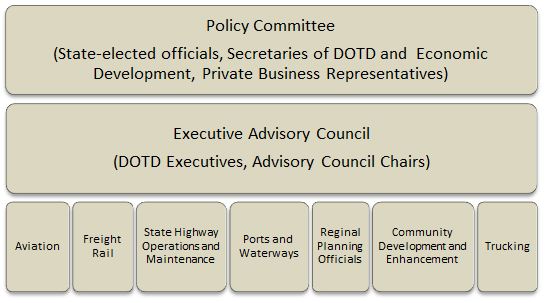Louisiana Statewide Transportation Plan Update - Overview
Everyone in Louisiana relies on transportation. Whether it is to move products to market, to fly into a city to attend a conference, to travel to work, or ride a bike to a park, transportation is involved. In the next 30 years, Louisiana’s economic health and quality of life may be at risk because of transportation funding challenges. Costs of providing infrastructure and services are up, but revenue is down. Maintaining what already exists continues to take a larger portion of available funds, leaving limited opportunities for addressing other significant transportation needs. This situation calls for a comprehensive look at how transportation can best address Louisiana’s needs in the long-term under the influence of the current economic climate. In short, what type of transportation investments will best serve Louisiana?
Background
In December 2003 the Louisiana Statewide Transportation Plan completed by the Department of Transportation and Development (DOTD) was adopted by the Louisiana Investment in Infrastructure for Economic Prosperity (LIIEP) Commission. The Plan, which included extensive participation and input from agencies and major stakeholders throughout the state, addressed multimodal transportation needs within the context of a growing economy. A few years later, Hurricanes Katrina and Rita redefined needs. As a result, a Review and Status report was completed in 2008 that considered the impacts of the storms and reported on the implementation status and updated construction costs of the 2003 Plan recommendations.
Since then, Louisiana, as well as the rest of the United States, has felt the consequences of the economic recession and limited transportation funding. It is time for a full update of the transportation plan to determine the most appropriate transportation investments and policies for Louisiana.
Scope of Current Plan
A series of technical tasks will be performed to answer the following key questions:
| What Should Transportation Do for Louisiana? |
Vision, goals, and objectives |
| Public involvement (see next section for examples) |
| How is it Performing Now? |
Performance measures |
| Existing Conditions Analysis (highway, trucking, aviation, freight rail, ports and waterways, surface transportation, intermodal facilities, intelligent transportation systems) |
| Issue Analysis (safety, climate change, energy consumption, sustainability/livability, access management, complete streets) |
| Public involvement (same as above) |
| What are Options for the Future? |
Financial analysis |
| Needs assessment (including detailed aviation and rail plans) |
| Project and program prioritization |
| Public involvement (same as above) |
| Statewide travel demand model update |
| What are the Investments and Policies that will Move Louisiana Toward the Vision? |
Draft and final plan |
| Public involvement (see next section for examples) |
| Final plan economic analysis |
Public Involvement Activities
Public involvement activities will help shape the responses to all four key plan questions. Examples of methods to be used include:
- Advisory Councils and Policy Committee – the following structure of councils made up of public and private sector stakeholders representing all modes of transportation will be used to provide technical/policy input throughout the process

- Public Opinion Telephone Poll – early in the process to provide input on vision, values, assessment of conditions, and willingness to pay for transportation improvements
- Legislative Questionnaire – questionnaire circulated early in the process to the Legislature on transportation funding issues
- Advocate Presentation Meetings – held approximately mid-way through the process to hear advocates present projects for consideration in evaluation and prioritization
- Plan Review Period – held when the draft plan is available for comment – details to be determined
How to Participate/Contact Us
Use the Comment Form to be involved in the process.
Overall Schedule
The Plan is to be completed and adopted by early 2014.